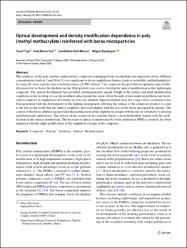Optical development and density modification dependence in poly (methyl methacrylate) reinforced with borax microparticles
Künye
Gül, Furkan Berke. Yiğit, Yusuf. Macun, Candidate Hilal ve Baydoğan, Nilgün (2023). Optical development and density modification dependence in poly (methyl methacrylate) reinforced with borax microparticles. Journal of Polymer Research 30 (539), 1-20.Özet
The synthesis of the poly (methyl methacrylate) composite containing borax decahydrate microparticles at two different
concentrations (such as 5 and 10 wt %) was significant to derive amphibious features (such as wettability and hydrophilicity)
by using the atom transfer radical polymerization (ATRP) method. The composite has provided an optimum optical identification level as borax decahydrate (as the filler particle) was used to develop the optical modification in this lightweight
composite. The optical development has provided a homogeneously spread of light at the surface and ideal identification
conditions in the working area as the modified optical properties were solved through several material problems and developed to improve its amphibious movement in corrosive ambient. Optical identification (by using colour coordinates) has
been generated with the development of the lighting homogeneity allowing the surface of the composite product to come
to the fore as the result that the surface roughness increased slightly with the rise of the borax microparticle amount. The
control of the borax addition has provided the modification of the amphibious design with the rise of wettability to develop
multifunctional applications. The surface of this composite has reached sligitly a more hydrophilic feature with the modification of the surface morphology. The decrease of optical transmittance by borax addition in PMMA synthesis has been
enhanced with the slight modification of the amphibious design of the composite.
Kaynak
Journal of Polymer ResearchCilt
30Sayı
539Bağlantı
file:///C:/Users/rumeysa.kaya/Downloads/s10965-023-03746-y.pdfhttps://hdl.handle.net/20.500.12846/857

















